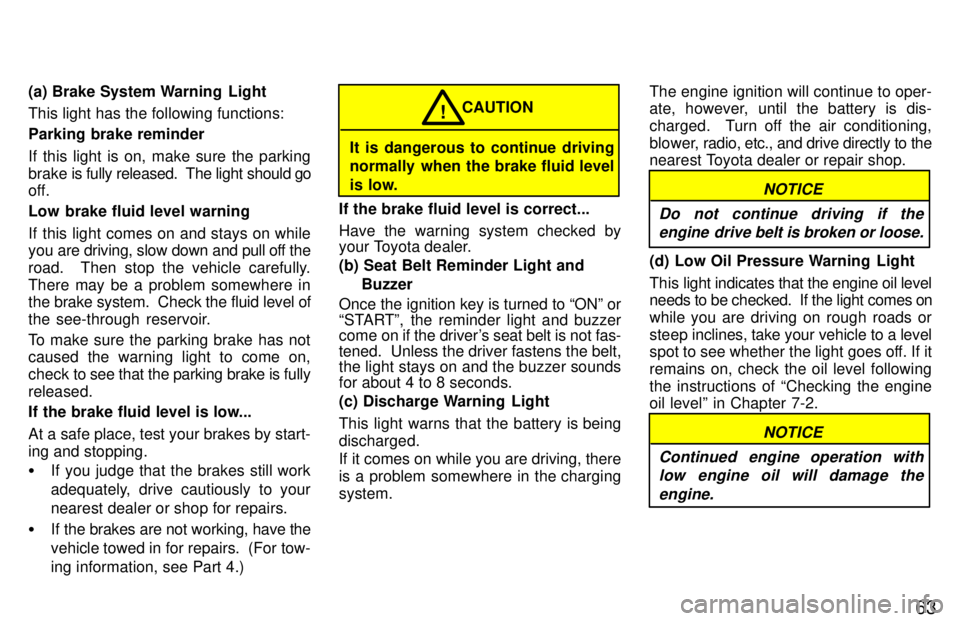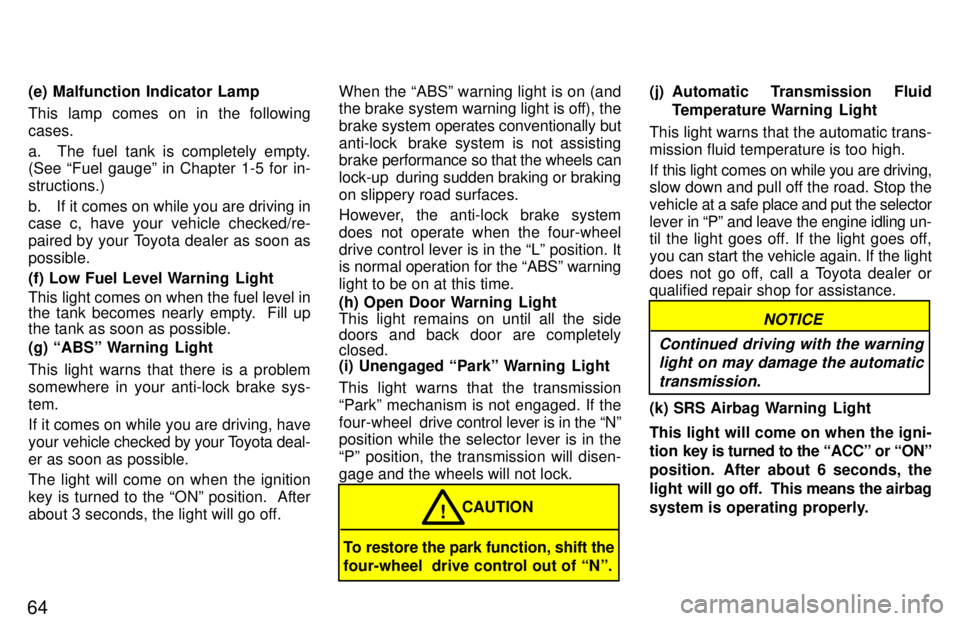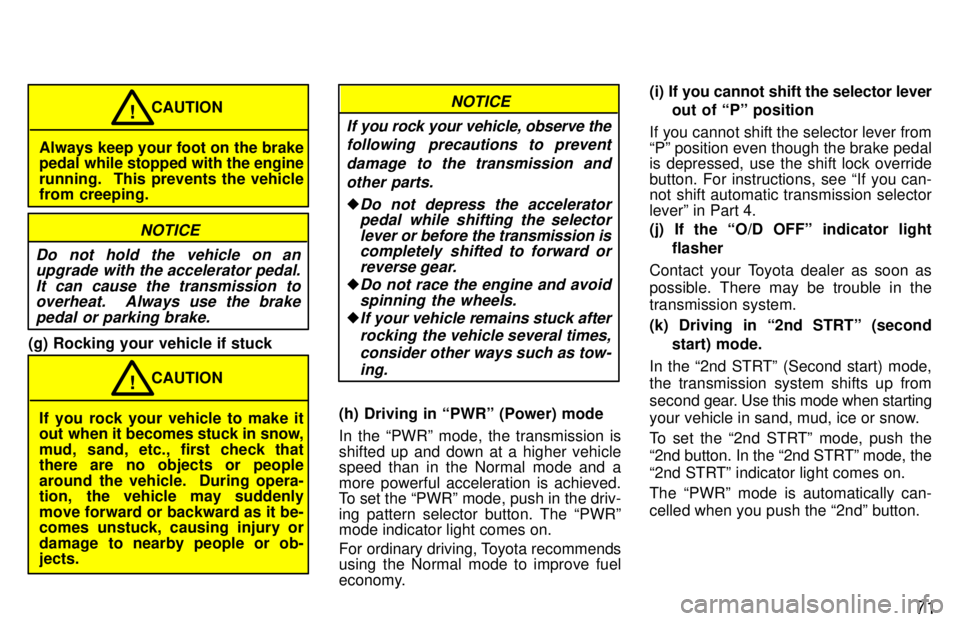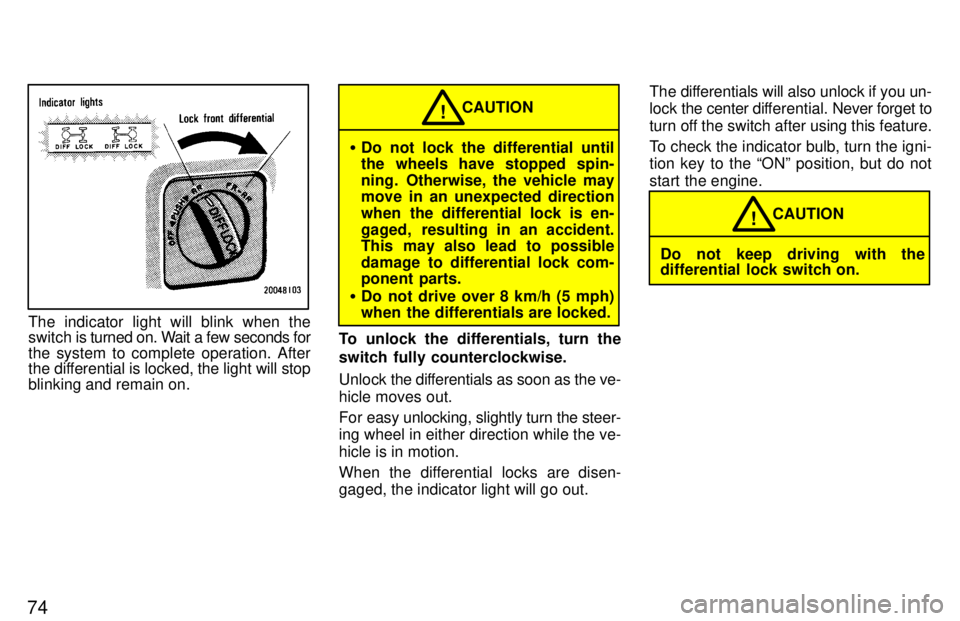1997 TOYOTA LAND CRUISER check engine
[x] Cancel search: check enginePage 35 of 159

60
The gauge indicates the engine cool-
ant temperature when the ignition
switch is on. The engine operating
temperature will vary with changes in weather and engine load.
If the needle moves into the red zone,
stop your vehicle and allow the engine to cool.
Your vehicle may overheat during severe operating conditions, such as: �Driving up a long hill on a hot day.
� Reducing speed or stopping after high
speed driving.
� Idling for a long period with the air con-
ditioning on in stop-and-go traffic.
� Towing a trailer.
NOTICE
�Do not remove the thermostat in
the engine cooling system as this
may cause the engine to overheat. The thermostat is designed tocontrol the flow of coolant to keep
the temperature of the engine within the specified operatingrange.
�Do not continue driving with an
overheated engine. See If yourvehicle overheatsº in Part 4.
The oil pressure gauge indicates en-
gine oil pressure when the ignition
switch is on. Check it while driving to
make sure that the needle is in the
proper range.
If the oil pressure should stay below the
normal range, pull off the road to a safe
place and stop the engine immediately.
Call a Toyota dealer or qualified repair
shop for assistance.
Oil pressure may not built up when the oil
level is too low. The oil pressure gauge is not designed to indicate oil level, and the
oil level must be checked using the leveldipstick.
Oil pressure gauge
Engine coolant temperature gauge
Page 36 of 159

61
NOTICE
Do not drive the vehicle with the oil pressure below the normal range
until the cause is fixed-it may ruin the engine.
The voltmeter tells whether the battery
is charged or discharged. Check it
while the engine is running-the
needle should always indicate as
shown above.
If the needle reads below or above the normal range while the engine is running,
it indicates the charging system needs im-
mediate repair.
However, it is normal for the needle to
drop below the normal range during en-
gine starting.The tachometer indicates engine
speed in thousands of rpm (revolu-
tions per minute). Use it while driving
to select correct shift points and to
prevent engine lugging and overrev- ving.
Driving with the engine running too fast
causes excessive engine wear and poor
fuel economy. Remember, in most cases
the slower the engine speed, the greater
the fuel economy.
NOTICE
Do not let the indicator needle get into the red zone. This may cause
severe engine damage.
Voltmeter Tachometer
Page 38 of 159

63
(a) Brake System Warning Light This light has the following functions: Parking brake reminder
If this light is on, make sure the parking
brake is
fully released. The light should go
off.
Low brake fluid level warning
If this light comes on and stays on while
you are driving, slow down and pull off the
road. Then stop the vehicle carefully.There may be a problem somewhere in
the brake system. Check the fluid level of
the see-through reservoir.
To make sure the parking brake has not
caused the warning light to come on,
check to see that the parking brake is fully
released.
If the brake fluid level is low...
At a safe place, test your brakes by start-
ing and stopping. � If you judge that the brakes still work
adequately, drive cautiously to yournearest dealer or shop for repairs.
� If the brakes are not working, have the
vehicle towed in for repairs. (For tow-
ing information, see Part 4.)
It is dangerous to continue driving
normally when the brake fluid level
is low. CAUTION
!
If the brake fluid level is correct...
Have the warning system checked by
your Toyota dealer. (b) Seat Belt Reminder Light and Buzzer
Once the ignition key is turned to ONº or
STARTº, the reminder light and buzzer
come on if the driver's seat belt is not fas- tened. Unless the driver fastens the belt, the light stays on and the buzzer sounds for about 4 to 8 seconds.
(c) Discharge Warning Light
This light warns that the battery is being discharged.
If it comes on while you are driving, there
is a problem somewhere in the chargingsystem. The engine ignition will continue to oper-
ate, however, until the battery is dis-
charged. Turn off the air conditioning,
blower, ra
dio, etc., and drive directly to the
nearest Toyota dealer or repair shop.
NOTICE
Do not continue driving if the engine drive belt is broken or loose.
(d) Low Oil Pressure Warning Light
This light indicates that the engine oil level
needs to be checked. If the light comes on
while you are driving on rough roads orsteep inclines, take your vehicle to a level
spot to see whether the light goes off. If itremains on, check the oil level followingthe instructions of Checking the engine
oil levelº in Chapter 7-2.
NOTICE
Continued engine operation with low engine oil will damage the
engine.
Page 39 of 159

64(e) Malfunction Indicator Lamp
This lamp comes on in the following cases.
a. The fuel tank is completely empty. (See Fuel gaugeº in Chapter 1-5 for in- structions.)
b. If it comes on while you are driving in case c, have your vehicle checked/re-
paired by your Toyota dealer as soon aspossible.
(f) Low Fuel Level Warning Light
This light comes on when the fuel level in
the tank becomes nearly empty. Fill up the tank as soon as possible.
(g) ABSº Warning Light
This light warns that there is a problem
somewhere in your anti-lock brake sys-tem.
If it comes on while you are driving, have your
vehicle checked by your Toyota deal-
er as soon as possible.
The light will come on when the ignition
key is turned to the ONº position. After
about 3 seconds, the light will go off. When the ABSº warning light is on (and
the brake system warning light is off), the brake system
operates conventionally but
anti-lock brake system is not assisting brake performance so that the wheels can
lock-up during sudden braking or braking
on slippery road surfaces.
However, the anti-lock brake system
does not operate when the four-wheel
drive control lever is in the Lº position. It
is normal operation for the ABSº warning
light to be on at this time.
(h) Open Door Warning Light
This light remains on until all the side doors and back door are completely closed.
(i) Unengaged Parkº Warning Light
This light warns that the transmission
Parkº mechanism is not engaged. If the
four-wheel drive control lever is in the Nº
position while the selector lever is in the
Pº position, the transmission will disen-
gage and the wheels will not lock.
To restore the park function, shift the
four-wheel drive control out of Nº. CAUTION
! (j) Automatic Transmission Fluid
Temperature Warning Light
This light warns that the automatic trans- mission fluid temperature is too high.
If this light comes on while you are driving,
slow down and pull off the road. Stop the
vehicle at a safe place and put the selector
lever in Pº and leave the engine idling un-
til the light goes off. If the light goes off,
you can start the vehicle again. If the light
does not go off, call a Toyota dealer or
qualified repair shop for assistance.
NOTICE
Continued driving with the warning light on may damage the automatic
transmission.
(k) SRS Airbag Warning Light This light will come on when the igni-
tion key is turned to the ACCº or ONº
position. After about 6 seconds, the
light w ill go off. This means the airbag
system is operating properly.
Page 40 of 159

65
The warning light system monitors the air-
bag sensor assembly, inflators, warning
light, interconnecting wiring and powersources.
If either of the following conditions occurs, this indicates a malfunction somewhere inthe parts monitored by the warning light
system. Contact your Toyota dealer as
soon as possible to service the vehicle. �
The light does not come on when the
ignition key is turned to the ACCº or
ONº position or remains on.
� The light comes on while driving.
(l) Key Reminder Buzzer
This buzzer reminds you to remove the
key when you open the driver's door with the ignition key in the ACCº or LOCKºposition.
CHECKING SERVICE REMINDER INDI-
CATORS
1. Apply the parking brake.
2. Open one of the side doors or the back
door.
The open door warning light should come on. 3. Close the door.
The open door warning light should go off.
4. Place the four-wheel drive control le-
ver in
Nº position and the selector lever in Pº position.
5. Turn ignition key to ACCº.
The SRS airbag warning light should
come on. It goes off after about 6 sec-onds.
6. Turn the ignition key to ONº, but do not start the engine.
All the service reminder indicators except the open door warning light and SRS air-
bag warning light should come on. The
ABSº warning light goes off after about 3 seconds. If any service reminder indicator or warn-
ing buzzer does not function as described above, either the bulb is burned out or the
circuit is in need of repair. Have it checked
by your Toyota dealer as soon as pos- sible.
Page 46 of 159

71
Always keep your foot on the brake
pedal while stopped with the engine
running. This prevents the vehicle
from creeping.CAUTION
!
NOTICE
Do not hold the vehicle on an upgrade with the accelerator pedal.
It can cause the transmission tooverheat. Always use the brake
pedal or parking brake.
(g) Rocking your vehicle if stuck
If you rock your vehicle to make it
out when it becomes stuck in snow,
mud, sand, etc., first check that there are no objects or people
around the vehicle. During opera-
tion, the vehicle may suddenly move forward or backward as it be-
comes unstuck, causing injury or
damage to nearby people or ob- jects. CAUTION
!
NOTICE
If you rock your vehicle, observe the following precautions to prevent
damage to the transmission andother parts.
�Do not depress the acceleratorpedal while shifting the selector
lever or before the transmission is
completely shifted to forward or
reverse gear.
�Do not race the engine and avoidspinning the wheels.
�If your vehicle remains stuck after
rocking the vehicle several times,consider other ways such as tow-ing.
(h) Driving in PWRº (Power) mode
In the PWRº mode, the transmission is shifted up and down at a higher vehicle
speed than in the Normal mode and a
more powerful acceleration is achieved.
To set the PWRº mode, push in the driv-
ing pattern selector button. The PWRº mode indicator light comes on.
For ordinary driving, Toyota recommends
using the Normal mode to improve fuel
economy. (i) If you cannot shift the selector lever
out of Pº position
If you cannot shift the selector lever fromPº position even though the brake pedal
is depressed, use the shift lock override
button. For instructions, see If you can- not shift automatic transmission selector leverº in Part 4.
(j) If the O/D OFFº indicator light flasher
Contact your Toyota dealer as soon as
possible. There may be trouble in the transmission system.
(k) Driving in 2nd STRTº (second start) mode.
In the 2nd STRTº (Second start) mode, the transmission system shifts up from
second gear. Use this mode when starting
your vehicle in sand, mud, ice or snow.
To set the 2nd STRTº mode, push the
2nd button. In the 2nd STRTº mode, the
2nd STRTº indicator light comes on.
The PWRº mode is automatically can-
celled when you push the 2ndº button.
Page 49 of 159

74
The indicator light will blink when the
switch is turned on. Wait a few seconds for
the system to complete operation. After
the differential is locked, the light will stop
blinking and remain on.
� Do not lock the differential until
the wheels have stopped spin-
ning. Otherwise, the vehicle may
move in an unexpected direction
when the differential lock is en-
gaged, resulting in an accident.
This may also lead to possible
damage to differential lock com-
ponent parts.
� Do not drive over 8 km/h (5 mph)
when the differentials are locked. CAUTION
!
To unlock the differentials, turn the
switch fully counterclockwise.
Unlock the dif ferentials as soon as the ve-
hicle moves out.
For easy unlocking, slightly turn the steer-
ing wheel in either direction while the ve- hicle is in motion.
When the differential locks are disen-
gaged, the indicator light will go out. The differentials will also unlock if you un-lock
the center dif ferential. Never forget to
turn off the switch after using this feature.
To check the indicator bulb, turn the igni-
tion key to the ONº position, but do not
start the engine.
Do not keep driving with the
differential lock switch on. CAUTION
!
Page 51 of 159

76
To avoid accidental cruise control
engagement, keep the CRUISE
ON-OFFº switch off when not using
the cruise control. CAUTION
!
SETTING AT A DESIRED SPEED
On vehicles with automatic transmission,
the transmission must be in Dº beforeyou set the cruise control speed.
Bring your vehicle to the desired speed, push the lever down in the SET/COASTº
direction and release it. This sets the ve-
hicle at that speed. If the speed is not sat-
isfactory, tap the lever up for a faster
speed, or tap it down for a slower speed.
Each tap changes the set speed by 1.6
km/h (1.0 mph). You can now take your
foot off the accelerator pedal.
If you need acceleration Ð for example,
when passingÐdepress the accelerator
pedal enough for the vehicle to exceed the
set speed. When you release it, the ve-
hicle will return to the speed set prior to the
acceleration. CANCELLING THE PRESET SPEED
You can cancel the preset speed by:
a. Pulling the lever in the CANCELº di-
rection and releasing it.
b. Depressing the brake pedal.
If the vehicle speed falls below about 40
km/h (25 mph), the preset speed will auto-
matically cancel out.
If the vehicle speed drops 16 km/h (10 mph) below the preset speed, the preset speed will also automatically cancel out.
If the preset speed automatically cancels
out other than for the above cases have your vehicle checked by your Toyota deal-
er at the earliest opportunity.
RESETTING AT A FASTER SPEED
Press the control lever upward in the
RES/ACCº direction and hold it. Release
the lever when the desired speed is at- tained. While the lever is held upward, the
vehicle will gradually gain speed.
However, a faster way to reset is to accel-
erate the vehicle and then press the con- trol lever downward in the SET/COASTºdirection. RESETTING AT A SLOWER SPEED
Press the control lever downward in the SET/COASTº direction and hold it. Re-
lease the lever
when the desired speed is
attained. While the lever is held down-
ward, the vehicle speed will gradually de-crease.
However, a faster way to reset is to de- press the brake pedal and then push the
control lever downward in the SET/
COASTº direction.
On vehicles with automatic transmission, even if you downshift the transmission by
turning off the overdrive switch with the
cruise control on, engine braking will not
be applied because the cruise control is
not cancelled. To decrease the vehicle
speed, reset to a slower speed with the
cruise control lever or depress the brake
pedal. If you use the brake pedal, cruise control is cancelled. RESUMING THE PRESET SPEED
If the preset speed is cancelled by pulling
the control lever or by depressing the
brake pedal or clutch pedal, pushing the
lever up in the RES/ACCº direction will
restore the speed set prior to cancellation.